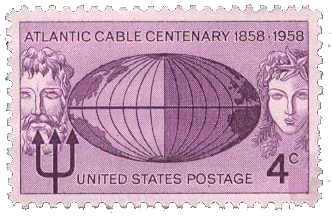150 Years of Transatlantic Telegraphy
January 5, 2017
Optical fibers spanning the
Atlantic carry the
Internet between the
major population centers of the world. The multitude of Atlantic
fiberoptic cables now in place are technological marvels.
Some of these have a
data rate far exceeding a
terabit/second with a
latency under 100
milliseconds. A standard
DVD optical disk of the type I use to
back up files on my
computer has a capacity slightly less than 0.005 terabytes.
Transatlantic data communication was first accomplished a few
decades after the
invention and improvement of the
telegraph by
Samuel Morse and many others in the 1830s. The first
transatlantic telegraph cables were placed in 1857 and 1858, but they did not work as planned. The idea that an
undersea cable, suitable toughened for its
environment, would work as well as its terrestrial counterparts was fundamentally flawed.
Air, which
electrically approximates a
vacuum to a large extent, has the lowest possible
relative permittivity, also known as the dielectric constant, with a value of 1.00.
Water has a very high dielectric constant at low, telegraph
frequencies (see figure), and
seawater has nearly an identical value, so these undersea cables had a high associated
capacitance. That capacitance, combined with the
electrical resistance of the cables, resulted in a very low data rate and high
signal loss.
Signalling was possible only when the cables were driven by extremely high
currents, and this resulted in their early demise.
Oliver Heaviside, a
maverick but knowledgeable
physicist and
electrical engineer of that era, explained all this by a simplification of
Maxwell's equations.
More importantly, Heaviside devised a solution to the problem; namely, adding
inductors, called
loading coils, along the transmission line to balance the capacitance. Another physicist,
William Thomson (Lord Kelvin) proposed that a reduction in cable resistance through use of a larger diameter
conductor, and thicker cable
insulation to reduce capacitance, would prove beneficial.
This first transatlantic cable was laid by two
ships, the
USS Niagara and the
HMS Agamemnon, each of which each carried half the cable.[2] They met in mid-ocean, the two cables were
spliced together, and they laid the cable to the opposite
shores.[2] The seven conductor cable was made from
copper wires triple-coated with the
natural latex,
gutta-percha, clad with
tarred hemp.[2] Eighteen
iron wires, wound in a close
spiral at the peripherey, added
mechanical strength.[2]
The cable laying was completed in August, 1858, but the cable quickly deteriorated, and it was useless by September 18, 1858.[2] Various factors, including the
American Civil War, discouraged another attempt until 1865, when that cable broke during placement.[2] Another attempt, this time successful, was made the next year by the
SS Great Eastern.
The SS Great Eastern, a vessel of nearly 18 ton's
weight and 211
meters length, was the largest vessel at that time.[2] It sailed from
Valentia Island, Ireland, to
Trinity Bay, Newfoundland, Canada, laying about 4,000
kilometers (2485
miles) of cable.[2]
Engineers had learned from previous failures, and the new cable was far more rugged, weighing 1,014
kilograms per kilometer.[2] The copper wires were three times larger in
cross-section than those of the 1858 attempt, and they were coated with an improved
insulator consisting of
Chatterton's compound with gutta-percha. A spiral of steel wires added stength, just as in the previous cables.[2]
Final connection was made at
Heart's Content, Newfoundland, on July 27, 1866. The Great Eastern then returned to the Atlantic, where engineers successfully retrieved the broken ends of the 1865 cable and spliced them together, giving the world two transatlantic cables in a single year.[2]
Since the
capital cost of these cables was large, it was expensive to send a transatlantic message. The inital price was $10/
word, with a ten word minimum ($100).[2] A $100 is equivalent to $1,500 in
today's money. Because of this high price, only 5% of the potential
data bandwidth was used, so the price was reduced to about half, and
revenues increased.[2] Still, only wealthy customers, such as
newspapers, used the service, and it led to the formation of
United Press International that shared stories among many newspapers.[2]
As mentioned in my primary reference to the 1865 cable, an article by
Robert Colburn, a
research coordinator at the
IEEE History Center,[2] the transatlantic cable has been recognized by two
IEEE Milestones. The first milestone was the Heart's Content terminal, recognized in 1985. The second milestone, in 2000, recognized the terminal sites at Ireland, Valentia Island,
Ballinskelligs, and
Waterville.[2]
References:
- Martin Chaplin, "Water and Microwaves," London South Bank University Web Site, December 18, 2015.
- Robert Colburn, "First Successful Transatlantic Telegraph Cable Celebrates 150th Anniversary," The Institute, IEEE, July 11, 2017.
- Lynden A. Jackson, "Submarine communication cable including optical fibres within an electrically conductive tube, US Patent No. 4,278,835, July 14, 1981.




